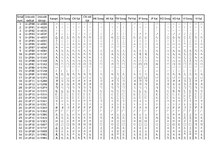Category talk:CJKV radicals and their variants in regular script style (in SVG format)
Style alignment[edit]
Hi there, I edited the shape so ![]() and
and ![]() within the series looks more similar in term of stroke styles. It was NOT the case before. So the changes I did :
within the series looks more similar in term of stroke styles. It was NOT the case before. So the changes I did :
- use kaishu font (which unfortunately was bold)
- edit so the stroke cross (unicode 5.0 shape fix) <---- I told that one Tom Bishop and Richard Cook and they fixed the Unicode

- use dynamic offset to thin it down
- fixed the bugs resulting from previous step
- clean up the nodes by hand : merge nodes + fix shape cycles = high quality simplification
- use document background from other file of the serie 640x640px
- resize based on variant's (1)'s size.
All good ! It looks great ! Yug (talk) 20:11, 1 October 2020 (UTC)
- Improvement possible: save as optimized svg (but this is broken on my computer). Yug (talk) 20:17, 1 October 2020 (UTC)
- Just noticed, the same is true for a hand of other characters. Is it actually voluntary ? Example below, with variant (1) clearly out of style. Yug (talk) 20:20, 1 October 2020 (UTC)
 Done[edit]
Done[edit]
-
WAS out of style
FIXED. Now in style.
-
WAS out of style
FIXED. Now in style. -
minor nodes fixes
-
WAS out of style
FIXED. Now in style. -
minor nodes fixes
-
WAS out of style
FIXED. Now in style. -
minor nodes fixes
-
WAS out of style
FIXED. Now in style. -
minor nodes fixes
-
WAS out of style
FIXED. Now in style. -
minor nodes fixes
-
WAS out of style
FIXED. Now in style. -
minor nodes fixes
-
minor nodes fixes
-
WAS out of style
FIXED. Now in style. -
minor nodes fixes
-
WAS out of style
FIXED. Now in style.
-
out of style
FIXED. Now in style.
-
out of style
FIXED. Now in style. -
out of style
FIXED. Now in style. -
minor nodes fixes
-
out of style
FIXED. Now in style. -
out of style
FIXED. Now in style. -
minor nodes fixes
-
out of style
FIXED. Now in style. -
--
-
minor nodes fixes
To overcome[edit]
-
out of style
-
out of style
-
out of style
-
out of style
-
out of style
-
out of style
Talk[edit]
Most of them are easy to fix by reusing a very resembling variant and hand-editing one stroke. Charlie ? Is it ok with you if we edit these files to do so ? Yug (talk) 20:42, 1 October 2020 (UTC)
- Sure, I appreciate any effort to improve the series. — I noticed the filesize went up from 3 KB to 13 KB, so I considered simplifying the new graphic a bit and removing superfluous stuff in a text/source code editor (Notepad++), but I came to the conclusion that it doesn't really matter. Love —LiliCharlie (talk) 23:40, 1 October 2020 (UTC)
- Inkscape has can save as "Optimized SVG", which wipe out unneeded metadata. But I broke it due to my D3js, SVG, Nodejs scripts, coding and testing. So I can't save under Optimized SVG anymore.
- But ok, good. So we can improve this serie. Noticed. I will move this talk to the ACC project. Yug (talk) 20:45, 2 October 2020 (UTC)
- Yes, I know Inkscape can save optimized SVGs with several options (unless that function is broken, of course). Yet to my taste there is still too much garbage left, and since that garbage is the same, or nearly the same, in all files Notepad++ can remove it in hundreds and even thousands of files simultaneously with a single command, and save them all with another single command, which is great for larger series. Bulk editing with or without regular expressions is great. Love —LiliCharlie (talk) 21:00, 2 October 2020 (UTC)
- Oh i see. You wanted PURE clean up. I see. Yes, optimized is only `good` clean up.
- I'am doing some progress by myself at good speed (2 radicals - 5 files per 30 minutes) and enjoying it. Therefor no need to migrate to ACC talk page for support. May require F5's refresh to see the changes tho. Yug (talk) 21:30, 2 October 2020 (UTC)
- (Done for today ! Yug (talk) 21:51, 2 October 2020 (UTC))
- Yes, I know Inkscape can save optimized SVGs with several options (unless that function is broken, of course). Yet to my taste there is still too much garbage left, and since that garbage is the same, or nearly the same, in all files Notepad++ can remove it in hundreds and even thousands of files simultaneously with a single command, and save them all with another single command, which is great for larger series. Bulk editing with or without regular expressions is great. Love —LiliCharlie (talk) 21:00, 2 October 2020 (UTC)
- Gets better. Style differences within the series becomes minimal.
- Variants ? (for later): Also, editing these files I realized you likely used 3~4 different fonts, which from my quick review seems each to consistently repeat the same variants : Dian on top -> mini-Shu on top. Could it be that one font is following Chinese Ministry of culture's shapes, another Taiwan MoE, another Japan's, another Korea ? If so, these variants could be named via a suitable suffixes. Yug (talk) 16:15, 6 October 2020 (UTC)
Needs review[edit]
 File:Regular_Style_CJKV_Radical_104_(0).svg -- see file history
File:Regular_Style_CJKV_Radical_104_(0).svg -- see file history File:Regular_Style_CJKV_Radical_117_(2).svg -- see file history
File:Regular_Style_CJKV_Radical_117_(2).svg -- see file history File:Regular_Style_CJKV_Radical_198_(0).svg -- see file history
File:Regular_Style_CJKV_Radical_198_(0).svg -- see file history File:Regular_Style_CJKV_Radical_098_(1).svg -- [EXISTING] uses Modern Chinese 4 strokes & ST, as per en:List of Xinhua Zidian radicals.
File:Regular_Style_CJKV_Radical_098_(1).svg -- [EXISTING] uses Modern Chinese 4 strokes & ST, as per en:List of Xinhua Zidian radicals. File:Regular_Style_CJKV_Radical_098_(0).svg -- [NEW] uses Traditional Chinese 5 strokes & S+T, as per en:List of Kangxi radicals.
File:Regular_Style_CJKV_Radical_098_(0).svg -- [NEW] uses Traditional Chinese 5 strokes & S+T, as per en:List of Kangxi radicals.
See also: File:瓦-tkaishu.png --Yug (talk)
File:瓦-tkaishu.png --Yug (talk)
Discussion[edit]
Hm. I tried to name the graphic that resembles the Kangxi shape most Regular_Style_CJKV_Radical_???_(0).svg. Is it possible to reverse swap filenames (or graphics)? Love —LiliCharlie (talk) 17:48, 6 October 2020 (UTC)
- Hello LiliCharlie,
- Admins could lead a files dance in 4 moves and 2 delete. But we have no admins in the team. We also have alternatives:
- Reupload upon existing
| Key short | Meaning (Key long) |
|---|---|
| Per locale-policy | |
| t | Taiwan (ROC) |
| j | Japanese |
| k | Korea |
| {nothing} | China (PRC) |
| h | Hongkong* |
| s | Singapore* |
| v | Vietnam* |
| Other in use | |
| a | atypical |
| i | irregular |
| Add positional-squeeze keys ? | |
| l | left of character |
| r | right |
| u | up |
| d | down |
| Add era-style ? | |
| x | kangxi |
| q | qing |
| *: no sure this one is in use. | |
- Devise a better naming scheme on the model of existing ones, but including a key variant, and then move to these empty file pages.
I think most of your variants are localization. (I have to check it up properly but from memory...) For the Stroke Order project we used a tiny country prefix (see rightside table). We could use it and expand it with have x=kangxi or q=Qing Kangxi. With filenames{zi}-{prefix}kaishu.svg
Alternatively, we could do as we did with the mingti-kangxi with a minor-style suffix. With filenames{zi}-kaishu-{suffix}.svg.
- Devise a better naming scheme on the model of existing ones, but including a key variant, and then move to these empty file pages.
- It depend on your sources and your analysis. Are we facing localisations or stylisations ? Yug (talk) 11:40, 9 October 2020 (UTC)
- @LiliCharlie: Oh. Important. An alternative is to keep this serie as a dedicated, variants-oriented serie, unrelated to ongoing MCC font+script efforts, where I wish to upload radicals + 300~1,000 very common Chinese characters in -kaishu.svg. Yug (talk) 17:14, 9 October 2020 (UTC)
- I'm in favour of uploading the graphic called
Regular_Style_CJKV_Radical_098_(0).svgtoRegular_Style_CJKV_Radical_098_(1).svg, and vice versa. As the Commons don't allow uploading an already existing file (no matter what its filename is) we will have to modify the file we upload first, and the cleanest way that does no harm is to insert a whitespace character somewhere, preferably the ASCII space. - Most of the graphics can be attributed to particular locales, but that doesn't apply to all of them; some may not reflect any current locale. I think it is best to consider them calligraphic styles that are to a certain degree independent of "official" shapes in contemporary political entities, though all of the "official" shapes should of course be illustrated.
- I don't think it is possible to find an encoded Unicode character for all of the variants. For example, 文 as a left-side radical is currently unencoded, and so is the last variant of 高 (毫 without 毛, or 亭 without 丁, i.e. ⿳亠口冖). Love —LiliCharlie (talk) 04:01, 11 October 2020 (UTC)
- 1) Ok, we keep this in mind for the renaming wave to come. If we go too slow (4 months), we just upload upon. 2) Locales or style: tricky (I need more time on this). 3) I'am not sure where lies the limits for unicode radicals supplements, it seems marginally random to me :
- I'm in favour of uploading the graphic called
- And you listed more of those in your serie. But I don't see a clear geometric logic. Why ⼈→⺅ with N→S is ok but ⽊→H-S-P-N with N→P isn't ? Maybe they inherited some historic classification system ? Yug (talk) 12:47, 12 October 2020 (UTC)
- I don't know the criteria the Unicode Consortium (or the Ideographic Research Group) applied in order to determine which radical variants to encode. What I found is the Unicode document CJK Ideograph Fragments by Mark Davis which contains a "not yet complete" table of Kangxi radical variants, and it seems that some of them are not (yet) in this series. Love —LiliCharlie (talk) 02:27, 13 October 2020 (UTC)
- 2010. It's not the first time I/we face such situation. It seems after the powerful push for unihan (unification) and rationalization in the 2000s, efforts have staled and the rare margin were never properly rationalized. Yug (talk) 09:02, 13 October 2020 (UTC)
- I don't know the criteria the Unicode Consortium (or the Ideographic Research Group) applied in order to determine which radical variants to encode. What I found is the Unicode document CJK Ideograph Fragments by Mark Davis which contains a "not yet complete" table of Kangxi radical variants, and it seems that some of them are not (yet) in this series. Love —LiliCharlie (talk) 02:27, 13 October 2020 (UTC)
- And you listed more of those in your serie. But I don't see a clear geometric logic. Why ⼈→⺅ with N→S is ok but ⽊→H-S-P-N with N→P isn't ? Maybe they inherited some historic classification system ? Yug (talk) 12:47, 12 October 2020 (UTC)
Summer migration[edit]
Hello User:LiliCharlie,
I now developed the bot and requested bot status to lead this migration. Current plan is as discussed above, followed by hand review :
- Bot:
- replace page content by proper, harmonized content and metadata.
- rename
Regular_Style_CJKV_Radical_???_(0).svg→⽊-(0)kaishu.svg - rename
Regular_Style_CJKV_Radical_???_(1).svg→⽊-(1)kaishu.svg - ...
- Human review: decide which locale or variant is occurring, see table "ACC's locale" in previous section. By example:
- rename
⽊-(0)kaishu.svg→⽊-tkaishu.svg(Taiwan) - rename
⽊-(1)kaishu.svg→⽊-xkaishu.svg(Kangxi) - rename
⽊-(2)kaishu.svg→⽊-kaishu.svg(base, mainland) - ...
- rename
Simplified characters as for Turtoise, Horse, will eventually move to simplified Chinese Unicode points.
As previously discussed, some variants may be out of our current naming scheme, we will then have to devise a fix.
Last, all your 497 files will keep their dedicated category (Category:CJKV radicals and their variants in regular script style (in SVG format)), so your set is, in that category, kept as a whole.
The renaming will occurs at the earliest around Summer 2021. Yug (talk) 07:51, 11 April 2021 (UTC)
Tentative[edit]
-
0→齒-kaishu.svg (CN, HK, TW, JP, KO, VI, KX)
-
1→歯-tkaishu.svg (TW, see comment below)
-
2→齿-kaishu.svg (CN, HK)
-
0→龍-xkaishu.svg (KX)
-
1→龍-jkaishu.svg (JP, KO, VI)
-
2→龍-tkaishu.svg (almost TW, see below)
-
3→龍-kaishu.svg (CN, HK)
-
4→竜-jkaishu.svg (JP, KO)
-
5→竜-kaishu.svg (CN, TW)
-
6→龙-kaishu.svg (CN, HK, TW)
Help welcome. Yug (talk) 22:25, 11 April 2021 (UTC)
- You can use Unicode's character code charts for this, especially the CJK Unified Ideographs chart. They show character shapes from the national standardization agencies of up to 6 locales (G=CN=Mainland China; H=HK=Hong Kong; T=TW=Taiwan; J=JP=Japan; K=KO=South Korea; V=VI=Vietnam). 齒 is on page 522, 歯 on p. 189, 齿 on p. 523, 龍 also on p. 523, and 竜 on p. 288, and 龙 on page 524. For KX=Kangxi I consulted my printed copy of the dictionary.
- CN, HK, and JP 歯 has a slightly different shape of 米 with only the first two strokes detached from the rest, and KO yet another one with a ㇏. The HK shape of 竜 without a final hook is missing, and so is the KX shape with a 一 on top.
- Note that CN and JP simplified characters often also have a defined official shape in other locales, including KX, and that complicated forms usually have one in CN and JP, too. Love —LiliCharlie (talk) 06:54, 12 April 2021 (UTC)
- I just noticed Unicode also has the Kangxi Radicals chart with the Kangxi shapes. Variant forms such as 竜 with a 一 on top (see above) are not on that chart, though.
- A note on the TW shape of 龍: The first stroke of ⺼ should be a tapering 丿 rather than a 丨 with a "fat" end. Love —LiliCharlie (talk) 07:53, 12 April 2021 (UTC)

- Hi Yug, I have produced and uploaded CJKV radicals — glyph comparison of 14 fonts from 7 locales.pdf which may help with this task. If you want more characters added, tell me so. Love —LiliCharlie (talk) 14:09, 13 April 2021 (UTC)
- (Note on numbering variants : File:虍-oracle.svg, File:虍-oracle-2.svg Yug (talk) 21:06, 19 April 2021 (UTC))






























































